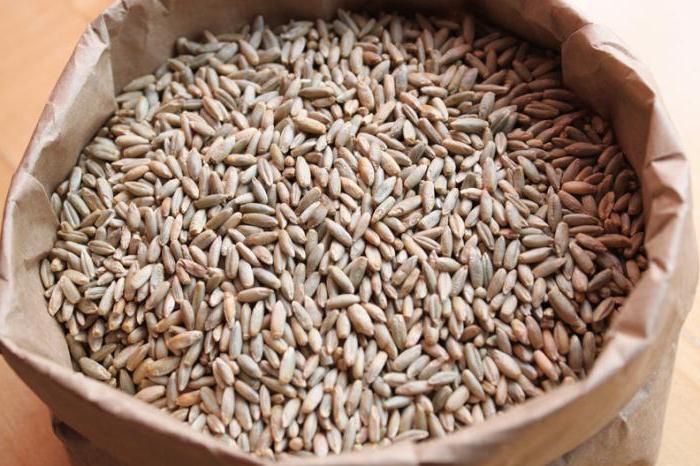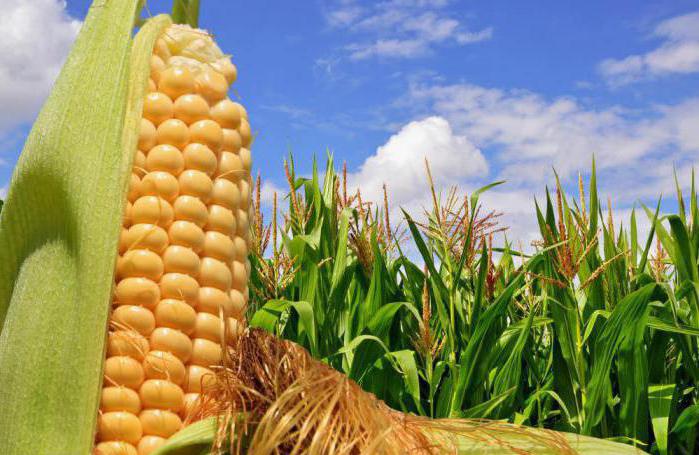A large family of cereals is the most famous representative of the class of monocots.
A varied ratio of proteins, carbohydrates, enzymes and vitamins in the composition of cereal crops meets the needs of the human body and is of value to animals. For people, on the basis of grain, such basic food products as flour and cereals are made, for animals - compound feed.
Cereals are characterized by a number of common features that distinguish them from other monocots.
Variety of cereals
Cereal crops are represented by two large groups.
The first includes types of cereals of the family of the same name (the so-called real breads):
- Wheat (including spelt - the ancestor of modern durum wheat).
- Rye.
- Oats.
- Barley.
- Triticale (hybrid, intermediate form of rye and wheat).
The second group consists of grain crops (millet bread) of the cereal family:
- Corn.
- Millet.
- Sorghum.
The millet genus includes varieties:
- Chumiza (capitate millet, buda, black rice) is cultivated in China, in the Far East.
- Paisa (wild millet, blackberry millet, Japanese millet) is cultivated in the Far East, Asia, Australia, and southern Africa.
- Mogar (Italian millet, Italian foxtail) is grown in the North Caucasus, Ukraine, Asia, Australia, Africa, North America.
- Dagussa (finger millet, eleusina korakan) grows in arid regions of Africa, Asia, and India.
In a separate group, cereals can be distinguished:
- Quinoa (other names: quinoa, rice quinoa). An ancient cereal that replaced rice and bread for the Incas. Marev family.
- Amaranth. It was used instead of wheat by the Aztecs and is still popular among the mountain tribes of China, Nepal, Pakistan, and India. Amaranth family.
- Buckwheat. The absence of gluten makes it unsuitable for baking bread, it is used for tortillas, fritters and pancakes. Buckwheat family.
These crops are not included in the family of cereals, however, they are similar in structure and nutritional value, they have a fruit in the form of a grain.
The structure of cereals and cereals
Cereal crops are characterized by common morphological features.
The root system is fibrous. Under favorable conditions, it goes 1.5-2 meters into the ground. The bulk of the roots is located in the upper soil layer, 25-30 cm from the surface. The roots of cereals are divided into 3 types:
- primary;
- secondary (adventitious);
- support (air) - only corn and sorghum have.
The stem is a thin straw divided by thickened partitions (stem nodes) along the entire length. The inner part of the stem in corn and sorghum is filled with parenchyma (pulp).
The sheet is linear in shape, the sheet plates are folded.
Inflorescences have the form:
- Spike-shaped (with a jointed rod and spikelets): rye, wheat, triticale, barley.
- Paniculate (with a central axis and lateral branches with spikelets): oats, rice, millet, sorghum.
- Panicle and cob combination: corn.
The flower consists of scales of two types:
lower (outer);
The flowers have a different development: in the first group of cereals, the lower ones are more developed, in the second group, the upper ones.
Between the flowers is the ovary (2 pinnate stigmas and 3 stamens; rice has 6 stamens).

Grain structure
The fruits of cereals are grains having the following structure:
- 2 shells: fruit (outer) and seed (inner).
- Endosperm (mealy kernel), which consists of protein and starch.
- An embryo containing sugars, nitrogenous substances, vitamins, fat, enzymes. It consists of 3 parts: a kidney, a germinal root, a shield - a conductor of nutrition for the embryo.
A distinctive feature of cereals of both groups is the structural features of the grain. In cultures of the first group, a longitudinal groove passes along the abdominal part of the grain (wide in wheat, barley, oats; in rye it is deep), the top is crowned with a crest (pubescence). The crest is absent only in barley. The cereals of the second group have neither groove nor pubescence.
The grain of each culture is different in shape. For cereals of the first group:
- ovoid (wheat);
- elongated, pointed to the base (rye);
- elongated, strongly narrowed along the entire length (oats);
- elliptical, in the form of a spindle (barley).
The surface of the grain is different:
- in wheat and barley - smooth;
- in rye - finely wrinkled;
- in oats - pubescent.
In cereals of the second group (bread crops), the shape of the grain can be of two types:
- elongated oval (rice);
- rounded (corn, millet, sorghum): corn kernels may have edges and sharpness in the upper part; millet grain - sharpness at the ends.
Pigments (chlorophyll, carotenoids) influence the color of the grain, forming the color range: from white, gray and greenish to red and black.

Spring and winter
There are 2 forms of cereals:
- Winter crops.
- Spring.
Spring crops are sown in the spring, they go through a full development cycle during the summer, the harvest is given in the fall (later winter crops).
Winter crops are sown in autumn. Before the beginning of winter, they have time to germinate, leave for wintering in the tillering phase and at rest, and in early spring of the next year, continuing their life cycle, they actively develop stems and begin fruiting in the middle of summer.
Winter varieties, using the reserves of soil moisture in the spring, give not only an earlier, but also a more abundant harvest.
Compared to spring varieties, winter varieties are less drought-resistant and require certain growing conditions:
- high snow cover and mild winters;
- fertile soil.
Cereals have both forms. Winter rye among them has the greatest frost resistance.
cultivation
Cereals are unpretentious, but still require some care. Under optimal conditions, the yield and grain quality will be higher.
The cereals of the first group (true breads) have low requirements for heat, but they need moisture. These are long-day plants, rapidly developing from germination to tillering.
There are 70 species in nature, but only 11 have economic value. The most famous is oats, which are used to make cereals, oat coffee, oatmeal, flour for confectionery and pancakes.
In animal husbandry, oats are used as a concentrated feed or as an integral part of mixed feed.
Cereals give oats the palm for the production of dietary and baby food: oatmeal cookies, muesli, Hercules cereal. The nutritional value of oats is due to the optimal content of proteins, starch, organic acids, fats and sugars, which are easily digestible, normalize metabolism, protect the heart and circulatory system.

Corn
Among cultivated cereals, corn occupies a special place, since in structure it does not resemble either representatives of real breads (the first group) or “brothers” from the second group, to which it directly belongs.
The stem is unusual: straight and powerful, capable of reaching 5 meters in height, equipped with aerial roots located on the lower aerial nodes.
The leaf plate is wide, the leaves themselves are long, pubescent from above.
Corn is a monoecious plant, but dioecious, since it has 2 inflorescences: the cob consists of female flowers, the panicle at the top is of male ones.
Breeders have bred a huge number of varieties and hybrids, on which the shape and color of the grains, located on the cob in vertical rows, depend.
The birthplace of corn is America (Central and South). The ancient Maya considered it a sacred plant worthy of worship.
In Europe, she appeared thanks to Columbus, who saw her for the first time on the island of Cuba.
The main composition of corn grain is starch (70%), protein (10%), fat (8%).
The use of corn is diverse: young cobs are boiled, grains are frozen and preserved, ground into cereals and flour. Further processing turns the grains into breakfast cereals, popcorn and other treats.
In animal husbandry, corn is considered a valuable fodder crop.
Rice
The progenitor of modern rice was known in India over 15 thousand years ago. The main areas of cultivation are the southern regions in the floodplains.
The son of water and the sun, the breadwinner of the East, the second bread of mankind, white gold is called this high-calorie cereal. And this is quite justified, because it feeds more than half of the world's population.
Rice grain is 75% starch, 8% protein; Rice shell is rich in vitamin B1.
The use of rice is varied: cereals and flour are made from grain, high-quality paper for writing, hats and mats are made from rice straw.
Two dozen species and over a thousand varieties of rice are grouped into 3 types according to their shape:
- Long grain - with a long and fine grain. Has maximum transparency. The use of this type of rice is universal for oriental and versatile cuisine: from salads to side dishes.
- Medium-grain - with grains wide and short. Less transparent than long grain, medium gluten content. The main purpose is paella, risotto, puddings.
- Round-grain - with round grains. Such rice is opaque, it has a high content of starch. Due to its high stickiness, it is used for making cereals, puddings, casseroles, sushi.
An interesting feature of rice is known: any variety has a different taste and color, depending on its processing and cooking time.

Millet and sorghum
The origin of millet as an agricultural crop dates back to the 3rd millennium BC.
Archaeological excavations in the Middle Transnistria testify that millet was cultivated by the ancient Scythians. It came to Europe from India, Mongolia and China. In ancient China, millet stood on a par with other sacred plants: rice, wheat, barley, soybeans.
Grain cereal is thermophilic and drought-resistant. Millet weevil is the smallest and hardest of all cereals, and its protein content is higher than that of wheat and barley.
Grain is used to make cereals, known to us as millet, and flour, from which cakes and bread are baked. All parts of the cereal are fed to livestock: grain, husks, straw, flour.
In cultural agriculture, there is a cereal that resembles millet. Sorghum has been used for 5,000 years in the arid regions of Africa as a staple bread. Outwardly, this grain cereal is similar to millet, according to the chemical composition of the grain - to corn.
Grains, flour, starch are produced from sorghum grains, wickerwork, paper and brooms are made from straw. Green mass is used as part of the silo.
